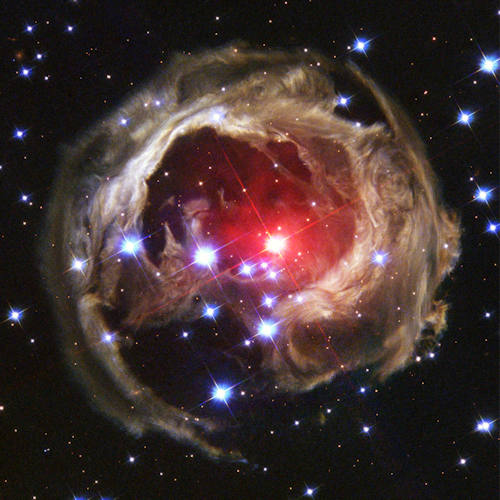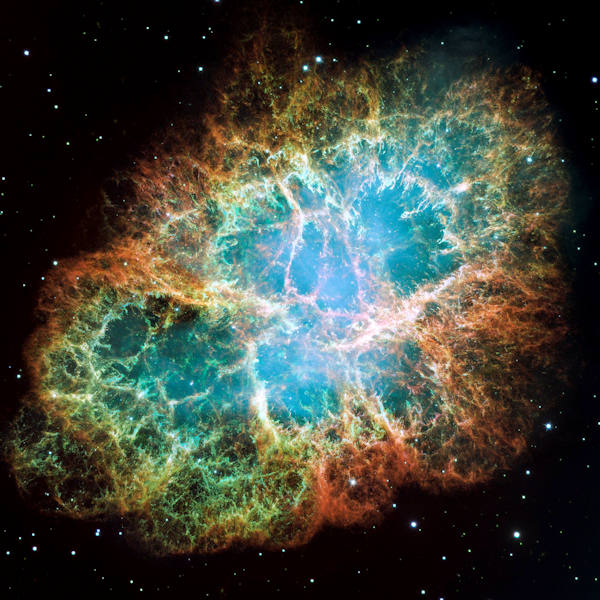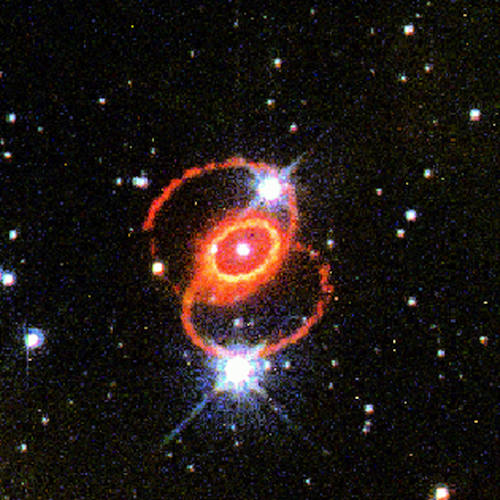Novae, Supernovae, and Related Cosmic Catastrophes
I’ve always been fascinated with fireworks. It seems to also be a general characteristic of people who study physics – physicists like to study things that blow up! There are some really powerful events that happen to stars from time to time that fascinate astronomers. These are of several types but are referred to under the terms “nova” and “supernovae.” The universe contains so many mysterious things and it is dynamic, not static. It seems to me that God also likes fireworks, but He makes his fireworks really big! There are a few other variations on these two terms, some of which are fairly recent discoveries, such as “micronovae,” “kilonovae,” and “macronovae.” This article will explain some on what these are. Note that to say “nova” or “supernova” is singular, but “novae” and “supernovae” are plural terms.
“He determines the number of the stars and calls them each by name. Great is our Lord and mighty in power; his understanding has no limit.” Psalm 147:4
In considering the Creator, we have an interesting statement in Psalm 147:4 above. In nova events a star temporarily brightens for some period of time and then goes back to normal. In supernovae, a star goes through a catastrophic permanent change where it becomes a different kind of object after some of it is blown out into space in the explosion. In some supernovae, the star can be completely destroyed. There are also events where stars can merge together into one object, causing a massive explosion. Scripture implies God is in control of the explosions of stars and of events that change the number of the stars. When there are supernovae, we should be very glad that they are so far away.
In 1572, astronomer Tycho Brahe coined the term “stella novae” when he saw what we now call supernova SN-1572. Novae and supernovae can look similar to the naked eye (if they are visible to the naked eye). A known star becomes much brighter and then fades or changes its appearance. In Tycho’s day, people were still influenced by the ideas from Aristotle. At that time people believed that anything in outer space beyond the Moon never changed. The universe outside of the Moon was supposed to be immutable and never change. But Tycho saw what seemed like a new star appear in the constellation Cassiopeia that hadn’t been visible before; and, it was brighter than Venus! He tried to estimate the distance to it (using parallax) but it was too far for him to measure. So, he concluded correctly that it was farther away than the Moon. So he had seen something change in space that wasn’t supposed to happen! This is why Tycho Brahe made the following statement: “I doubted no longer. … In truth, it was the greatest wonder that has ever shown itself in the whole of nature since the beginning of the world, or in any case as great as [when the] Sun was stopped by Joshua’s prayers.”
It took many years for astronomers to figure out what these “new stars” were. First, I will explain nova and supernova Type Ia because they are similar in some respects. A nova occurs when a white dwarf star is bound to a normal star (a binary star system). If the normal star gets close enough to the white dwarf matter may be pulled off the normal star onto the white dwarf. The white dwarf is a star that has compressed over time due to gravity and has used up its fuel, and it is very dense and hot. If a stream of gas falls onto the white dwarf but it is not enough to envelope the white dwarf completely, it is possible for nuclear fusion to trigger in a localized spot on the white dwarf’s surface. This gives off a powerful flare of light and energy that can make the star look much brighter. This is a nova. A Type Ia supernova is relatively rare but it also involves a white dwarf pulling matter off of another star. In a Type Ia supernova, the gas falling on the white dwarf is much more, enough to envelope and put pressure on the white dwarf. Type Ia supernova are not totally understood though. But for Ia events there will be a runaway nuclear fusion process that causes a massive explosion. This explosion can be great enough to completely destroy the white dwarf star. An explosion like this also sends out a powerful shockwave into space.
Supernovae that are of Type II, Type Ib and Ic are also similar to each other. An important fact about the Type I supernovae events is their light shows there’s no hydrogen in the explosion. Hydrogen is easily detected in the light spectrum, if present. However Type II supernovae do have evidence of hydrogen. A Type II supernova does not happen due to two stars interacting but is more related to a star reaching what you could call its “old age” where it is running out of hydrogen fuel. Running out of hydrogen sets off changes in the star that depend on how massive the star is. So, a Type II supernova is called a “core collapse” supernova because this is what happens inside the star. In just a few seconds the core of the star can collapse and this creates forces that cause it to explode. A Type II supernova happens in a star that is between 8 and 40 times the mass of our Sun. These explosions give off great energy and some of them, if seen from Earth could be visible in the daytime, even in bright sunlight. But scientists cannot actually predict when a supernova will happen. The star Betelgeuse (in the constellation Orion) is a red supergiant star and scientists suspect it is nearing the end of its hydrogen, which means it could explode. Some have said it could happen in 2022. But we really have no way of knowing. To a star, “soon” could mean a thousand years from now.
A star nearing its “old age,” running low on hydrogen starts using other elements for fuel. This causes the star to stratify into layers (like the layers of an onion) where the various layers are each more concentrated in a certain element. The highest pressures and temperatures near the center could form some of the higher atomic weight elements. The highest atomic number element able form inside a star is Iron, so it would be near the center. Then going from the center outward there can be Silicon, Magnesium, Neon, then Oxygen, then Carbon, then Helium, then hydrogen that is not as hot and cannot fuse into Helium. There may be other elements from the periodic table that form also if the temperatures are high enough. In a Type Ib supernova, the outer Hydrogen layers can be used up or thrown off before the explosion, leaving the Helium layer as the outermost layer, until the star collapses and then explodes. In a Type Ic supernova, the outer layers of Hydrogen and Helium are used up or thrown off making Carbon the outermost layer. Then if massive enough gravity causes the star to collapse and then it explodes.

Another type of event has a couple of names, Kilonova or Macronova. These are thought to come from when two dense objects collide and merge together (not normal stars but possibly one of them being a neutron star and another one maybe a white dwarf). They create a lot of light but the visible light is followed by infrared and other types of radiation. The collision of dense objects like this is one of the events that scientists use to search for gravitational waves. Gravitational waves are ripples in the fabric of space as Einstein described them. These Kilonova/Macronova events are thought to create a lot elements from the periodic table above Iron. Another kind collision and merger of two normal stars is a less powerful explosion but is called a luminous red nova. In a luminous red nova, normal stars merge into a red giant star. These create beautiful nebulas with a bright red star in the center. Thus, as man-made fireworks can make for great pictures if you can capture them, so can God’s fireworks out in space.

When have supernovae been actually seen in history? In 1054 a supernova happened that was witnessed by the Chinese, Japanese, and by American Indians. This one created the supernova remnant nebula we call the Crab Nebula (pictured above). Beautiful pictures have come from this massive explosion. Another famous one was not so long ago, in 1987. Now called SN-1987A (‘A’ because it was the first one of that year.) Astronomers studied 1987A a great deal. Some hours before it was seen neutrinos were detected. Then some months later we began to see rings of hot gas expanding away from it. It was eventually determined the star that exploded was called Sanduleak -69 202. Sanduleak was about 168,000 Light-Years away in the Large Magellenic Cloud, which is a small galaxy orbiting our galaxy, the Milky Way.

In observing supernovae over the years, astronomers have found an interesting way to detect that a supernova has happened sometime in the past. They can look for light emissions from a radioactive isotope of Aluminum. This was reported in a paper from the Royal Astronomical Society in July 2020, from a research project of the ESA. Aluminum-26 (Al-26) is found in the shockwaves from supernovae explosions. It seems to be a very good way to “look for” supernovae. But this has lead to a recent discovery that is a mystery about our own Galaxy, the Milky Way. There is evidence of Al-26 around our galaxy but it doesn’t fit what scientists would have expected. There is something called the scale height that is a measure of how a gas fades away with distance from an object. So if it fades away quicker it has a lower scale height, but if it fades away slower it has a bigger scale height. Or if the gas is more dense it has a bigger scale height. Alumnium-26 is observed to have a scale height of 800 for above the disk of our galaxy. If this Al-26 came from stars in our galaxy going supernova, scientists would expect the scale height to be only about 50. So it raises the question, where does all the Al-26 come from? Secondly, the Al-26 around the galaxy is moving faster than the galaxy disk. The spiral arms of the galaxy rotate around the center of the galaxy at a certain speed based on the distance from the center. But the Al-26 is essentially rotating about 100 to 200 km/second faster than the galaxy disk spins. This is puzzling to scientists because scientists tend to assume that all the Al-26 comes from supernova in the galaxy. But if that is the case, why is it moving faster than the galaxy? The researchers are suggesting the Al-26 comes from outside our galaxy.
God displays his greatness in the vastness and the mysteries of our universe. He creates beauty from explosions powerful beyond our understanding. There is no explosion too big for God to be in control over it. Yet, in his unlimited power, He wants a relationship with us and cares about each of us. In the work of Jesus Christ he has gone to great lengths to provide us a way to know him in a personal relationship. I want to finish this with some selections from Isaiah chapter 40 (NIV 1984 Bible).
“Who has measured the waters in the hollow of his hand,
or with the breadth of his hand marked off the heavens? . . .
Whom did the Lord consult to enlighten him,
and who taught him the right way? . . .
Surely the nations are like a drop in a bucket;
they are regarded as dust on the scales;
he weighs the islands as though they are fine dust. . . .
Do you not know? Have you not heard?
Has it not been told you from the beginning?
Have you not understood since the earth was founded?
He sits enthroned above the circle of the earth,
and its people are like grasshoppers.
He stretches out the heavens like a canopy,
and spreads them out like a tent to live in. . . .
Why do you say, O Jacob, and complain, O Israel,
My way is hidden from the Lord;
my cause is disregarded by my God?
Do you not know? Have you not heard?
The Lord is the everlasting God,
the Creator of the ends of the earth.
He will not grow tired or weary,
and his understanding no one can fathom.
He gives strength to the weary and increases
the power of the weak.”

